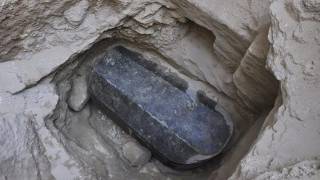Before The Pharaohs: The Evidence for Advanced Civilisation in Egypt’s Mysterious Prehistory
Source: wakingtimes.com
[...]The Great Pyramid – A Device The easily observable and obvious differences in the Giza pyramids and the Sakkara pyramids, which were all supposed to have been built during the same era, are a problem. Clearly, the construction techniques, as well as materials, for the Giza pyramids were different than those at Sakkara, or else we would expect pyramids at both sites to have stood the test of time in a similar manner. They did not. The important point is why. Did the engineers and construction workers of the Old Kingdom not pass along their methods from the fourth to the fifth dynasty? It seems they did not, which is a very curious occurrence given the stability of Egyptian civilisation. It may also be the case that the fourth dynasty Egyptians did not build the Giza pyramids.
The easily observable and obvious differences in the Giza pyramids and the Sakkara pyramids, which were all supposed to have been built during the same era, are a problem. Clearly, the construction techniques, as well as materials, for the Giza pyramids were different than those at Sakkara, or else we would expect pyramids at both sites to have stood the test of time in a similar manner. They did not. The important point is why. Did the engineers and construction workers of the Old Kingdom not pass along their methods from the fourth to the fifth dynasty? It seems they did not, which is a very curious occurrence given the stability of Egyptian civilisation. It may also be the case that the fourth dynasty Egyptians did not build the Giza pyramids.No other pyramid in Egypt (the world for that matter) is like the Giza pyramids, and in particular the Great Pyramid. Additionally, there is no direct evidence to support the claim that the Great Pyramid, or the other Giza pyramids were tombs. Nor is there any record left by its builders as to what it was for or when it was built. This creates a problem of explanation. If the Great Pyramid was not a tomb, then what was it? A mystical temple for initiation ritual, or a public works project designed to unify the country? Or, was it something else entirely? Theories are abundant, but the only theory I am aware of that covers all aspects of the Great Pyramid’s interior design, is Christopher Dunn’s theory that it was a device. According to Dunn, the Great Pyramid was a machine for producing power by converting tectonic vibration into electricity.
There are a number of reasons to accept Dunn analysis. First, he explains the interior design and all other evidence within the Great Pyramid in a cohesive manner. Second, he demonstrates the technical skills required to accomplish precision construction. Third, Dunn’s expertise and career is in the precision fabrication and manufacturing industry, which makes him uniquely qualified to express a professional opinion on the techniques and tools of the Giza pyramid builders.
The fact is, modern construction companies could not build the Great Pyramid today without first inventing specialised tools and techniques in order to deal with blocks of stone that vary in weight from ten to fifty tons. Such an endeavour would be on a magnitude equivalent to building a hydroelectric dam or a nuclear power station requiring tens of billions of dollars in resources. Although our modern economy is different than that of the ancient world, the resource required now as compared to then is the same! The stone must be quarried and moved and the workers must be paid. The fact that an extremely large amount of resources were dedicated to Giza pyramid development over a long period of time demands, in my opinion, that pyramid building was utilitarian, and not for any fourth dynasty pharaonic vanity of having the largest headstone in the world.
Prehistory – Evidence and Perspective
For me, the evidence clearly tells a very different story of early dynastic Egypt. Sometime around 3000 BCE, the establishment and growth of permanent settlements in the Lower Nile Valley led to the development of civilisation. Why Giza and the surrounding area were chosen as the focal point for early Dynastic Egypt was because ‘civilisation’ had been there before, as the three pyramids and the Great Sphinx testify. Without knowing what the pyramids were designed for, the early Egyptians also assumed they must have been tombs. As a result, they rejuvenated the Giza Plateau and turned it into a Necropolis, then expanded to Sakkara where they built tombs in pyramid form, albeit of lesser quality and not brandishing the skills the original builders of the Giza pyramids demonstrated. Pyramid building, even the smaller ones at Sakkara, was resource intense, so the Egyptians reverted to burying their nobility in the traditional mastaba.
This scenario, which calls for an earlier civilisation with advanced technical skills, poses another problem. It does not fit the standard model of history. However, the notion that an earlier civilisation existed does not rest on the Giza pyramids alone. There is also the Sphinx, which in 1991 was geologically dated to between 7,000 and 9,000 years old by the team of John Anthony West and geologist Dr. Robert Schoch. Add to that the megaliths of Nabta Playa in southwestern Egypt, which is believed to have been a star viewing diagram, according to astrophysicist Dr. Thomas Brophy, that relates not only the distance from Earth to the belt stars of Orion, but their radial velocities as well. Another ‘head scratching’ discovery is the 1260-ton foundation stones of the Baalbek temple, west of Beirut in Lebanon, one of which was left in its quarry.
Clearly history has its secrets, but there is enough evidence to validate, as theory, that civilisation is much older than we have previously believed. History, according to the ancient Egyptians themselves, confirms this. According to the Papyrus of Turin, which is a complete list of kings up to the New Kingdom, before Menes (before 3000 BCE) the:
…venerables Shemsu-Hor, [reigned] 13,420 years
Reigns up to Shemsu-Hor, 23,200 years2
These two lines in the king’s list are explicit. According to their documents, the total years of Egyptian history goes back 36,620 years. The argument that the years in the king’s list do not represent actual years, but some other, shorter, measurement of time seems more of an attempt to explain away than to explain. The ancient Egyptians employed a sophisticated calendar system that involved a 365-day year, which was periodically corrected through the predictable and cyclical nature of the star Sirius. Every 1,461 years, the heliacal rising of Sirius marked the beginning of the new year. A single Sirius cycle corresponds to 1,461 years, where each year is equivalent to 365.25 days. In essence, the marking of the New Year at the heliacal rising of Sirius was the ancient Egyptian’s ‘leap year.’ Of course, determining the length of Sirius’ cyclical nature requires stellar observation over thousands of years which means the origins of pharaonic Egypt, or its source of knowledge, must originate in the remote past.
Late twentieth century Egyptologist Walter Emery seems to have agreed in principle that the origins of ancient Egypt date well into prehistory. Emery believed that ancient Egypt’s written language was beyond the use of pictorial symbols, even during the earliest dynasties, and that signs were also used to represent sounds, along with a numerical system. When hieroglyphics had been stylised and used in architecture, a cursive script was already in common use. His conclusion was that:
All this shows that the written language must have had a considerable period of development behind it, of which no trace has as yet been found in Egypt.3
Ancient Egyptian religion also testifies to a considerable period of development. Their religion, which is more of a philosophy of nature and life than it is a ‘religion,’ is based on a level of sophistication that, in all respects, appears more scientific than it does mythical.
Symbolism and Nature: The Method of Egyptian Thought
From a modern Western perspective their religion has been billed as primitive and polytheistic, and appears as a mythological menagerie of gods. Nothing could be further from the truth. The source of this misunderstanding stems from the Egyptian word neter being translated into Greek as ‘god,’ which later took on the Westernised meaning of deity. The true meaning of neter was to describe an aspect of deity, not a deity to be worshipped. In essence, neters referred to principles of nature in a practical scientific way.
Yet, the meaning of a specific neter was communicated in a visually symbolic manner. When a human was depicted with an animal head, this signified the principle as it occurs in man. If the whole animal was depicted it was a reference to a principle in general. Alternatively, a human head depicted on an animal represented that principle as it relates to the divine essence within mankind, not any person in particular, but the archetypal; as the immortal Ba is represented by a human-faced bird.
Another example is Anubis (the jackal), who presided over the process of mummification. He did so as a representation of the decomposition or fermentation process. In nature, the jackal keeps its prey and allows it to decompose before consumption. Therefore, he who presided over the mummification ritual was depicted in art as a man with the head of the jackal, thereby representing man’s death as the digestive principle found in nature. From a universal perspective, the decomposition of a body is, to Nature, digestion. Hence, those organs associated with digestion, after being removed from the deceased, were placed in a Canopic jar with a lid shaped in the image of the jackal’s head.
Before the Pharaohs
The sudden emergence of Dynastic Egypt, at the beginning of the third millennium BCE, is one of civilisation’s greatest mysteries. How did this supposedly primitive North African culture organise itself into a civilisation of such magnificence? One aspect that I believe has been overlooked is that mankind – anatomically modern humans – has been around for a very long time. According to recent genetic studies, all people today are the descendents of a single African woman who walked the Earth 150,000 years ago. According to geneticists, her mitochondrial DNA exists in all of us.
[...]
Read the full article at: wakingtimes.com
Tune into Red Ice Radio:
Roundtable - Hour 1 - Man’s Genesis & The Future Direction of Humanity
Christopher Dunn - The Hidden Chamber Behind Gantenbrink’s Door & The Giza Power Plant
Robert Bauval - Black Genesis, The Ancient People of Nabta Playa & Mars Anomalies
Robert Bauval - Tutankhamun’s DNA, Zahi Hawass’ Chasing Mummies, The Enlightenment & Scottish Rite Freemasonry
Robert Bauval - The Master Game & Armageddon
Robert Bauval - Post-Revolution Egypt
Robert Schoch - Hour 1 - The Mystery of the Sphinx
Laird Scranton - Hour 1 - The Velikovsky Heresies
John Anthony West & Laird Scranton - Göbekli Tepe, Egypt & The Dogon
Egypt Roundtable - Hour 1 - Ancient Technologies & Khemitology
Thomas Brophy - Archaeoastronomy, Precession, Yuga Cycles & The Golden Age






















